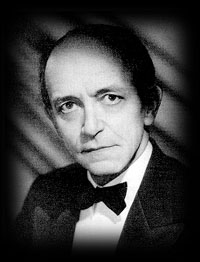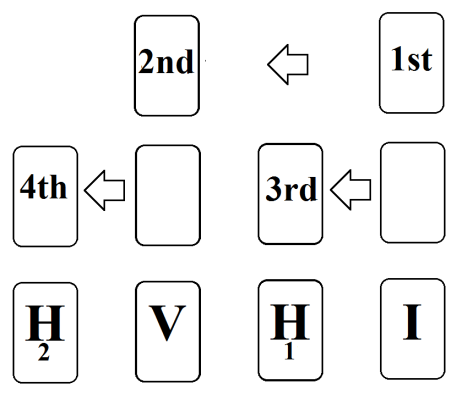A 10-Week Independent Study Course with Paul Foster Case: A Review of Oracle of the Tarot (1933).
 Paul Foster Case (1884 – 1954) is one of the most influential American occultists on modern tarot studies. His approach to tarot is influenced heavily by Western astrology and the Hermetic Qabalah, as evidenced in his tarot divination course, Oracle of the Tarot, and other writings, such as An Introduction to the Study of Tarot (1920) or The Tarot: A Key to the Wisdom of the Ages (1947). Oracle is keyed to the Knapp-Hall Tarot, which was first published by J. Augustus Knapp and Manly P. Hall in 1929. The Knapp-Hall Tarot differs significantly from the Marseille, Rider-Waite-Smith, or Thoth interpretive traditions, so the card meanings in Oracle, in particular from the Minor Arcana, are not readily transferrable to the Marseille, Rider-Waite-Smith, or Thoth systems. Nonetheless, Oracle offers the beginner and intermediate student a strong foundation in the basics and anatomy of tarot.
Paul Foster Case (1884 – 1954) is one of the most influential American occultists on modern tarot studies. His approach to tarot is influenced heavily by Western astrology and the Hermetic Qabalah, as evidenced in his tarot divination course, Oracle of the Tarot, and other writings, such as An Introduction to the Study of Tarot (1920) or The Tarot: A Key to the Wisdom of the Ages (1947). Oracle is keyed to the Knapp-Hall Tarot, which was first published by J. Augustus Knapp and Manly P. Hall in 1929. The Knapp-Hall Tarot differs significantly from the Marseille, Rider-Waite-Smith, or Thoth interpretive traditions, so the card meanings in Oracle, in particular from the Minor Arcana, are not readily transferrable to the Marseille, Rider-Waite-Smith, or Thoth systems. Nonetheless, Oracle offers the beginner and intermediate student a strong foundation in the basics and anatomy of tarot.
Case opens the book with a strong statement: “TAROT divination is not fortune-telling. The practice of fortune-telling is based on the false notion that human life is governed by luck, chance, or fate–by obscure powers at work outside the personality. True divination rests upon the occult truth that the causes of all events in human life are really internal.” He thus begins by distinguishing divination from fortune-telling. Divination is an inward reflection process of using tarot to tap into the superconscious. The tarot utilizes imagery and symbols that communicate in the language of the superconscious and thus understanding tarot is in its essence the learning of a new language.
The introductory Lesson 1 warns the tarot practitioner to take tarot divination seriously and reviews a few ethical guidelines, in particular the practitioner’s duty of confidentiality and impartiality. Practitioners must remain non-judgmental when conducting tarot readings. Lesson 1 also subdivides tarot decks into exoteric and esoteric decks. Case provides the Knapp-Hall Tarot as an example of an exoteric deck, or one that operates in the realm of public knowledge, with imagery that more closely resembles the tarot deck originally used for playing games, and contrasts that with the Rider Tarot (or Rider-Waite-Smith), which he refers to as an esoteric deck. Esoteric tarot decks are the versions of tarot re-interpreted by occultists and used specifically for divination or other spiritual exercises.
Note that it is unclear and somewhat contradictory as to why Case expends the first half of the Introduction to describe tarot divination as an internalized process, but then applies an exoteric deck to teach divination, rather than an esoteric deck, which would seem to be more aligned with the internalized process of tarot divination. What’s more, the subsequent lessons in Oracle repeatedly reference esoteric tarot traditions.
The 10 lessons of Oracle are meant to be studied over a course of 10 weeks.
Lesson 1 then proceeds to describe the anatomy of the Major and Minor Arcana (referred to as the Major Trumps and Minor Trumps in Oracle). Case claims that his Hebrew letter attributions for the Major Arcana are the “correct” attributions and that preceding claims by such authors as Papus were wrong. Case sources his attributions from Eliphas Levi (1810 – 1875), a French occultist and influential writer on tarot. Case claims that his Hebrew letter attributions are better aligned with the standard astrological attributions of the Major Arcana, which he provides as follows:
Case’s Hebrew and Astrological Attributions in the Major Arcana
|
Key |
Major Arcana | Hebrew Attribution | Astrological Attribution |
|
0 |
Le Fou (The Fool) | Aleph (A) | Air; Uranus |
|
1 |
Le Bateleur (The Magician) | Beth (B) | Mercury |
|
2 |
La Papesse (The High Priestess) | Gimel (G) | The Moon |
|
3 |
L’imperatrice (The Empress) | Daleth (D) | Venus |
|
4 |
L’empereur (The Emperor) | Heh (H) | Aries |
|
5 |
Le Pape (The Hierophant) | Vau (V) | Taurus |
|
6 |
L’amoureux (The Lovers) | Zain (Z) | Gemini |
|
7 |
Le Chariot (The Chariot) | Cheth (Ch) | Cancer |
|
8 |
La Justice (Justice) | Lamed (L) | Libra |
|
9 |
L’ermite (The Hermit) | Yod (I) | Virgo |
|
10 |
La Roue de la Fortune (Wheel of Fortune) | Kaph (K) | Jupiter |
|
11 |
La Force (Strength) | Teth (T) | Leo |
|
12 |
Le Pendu (The Hanged Man) | Mem (M) | Water; Neptune |
|
13 |
La Mort (Death) | Nun (N) | Scorpio |
|
14 |
La Temperance (Temperance) | Samekh (S) | Sagittarius |
|
15 |
La Diable (The Devil) | Ayin (O) | Capricorn |
|
16 |
Le Feu Du Ciel (The Tower) | Peh (P) | Mars |
|
17 |
Les Etoiles (The Star) | Tzaddi (Tz) | Aquarius |
|
18 |
La Lune (The Moon) | Qoph (Q) | Pisces |
|
19 |
Le Soleil (The Sun) | Resh (R) | The Sun |
|
20 |
Le Jugement (Judgement) | Shin (Sh) | Fire; Pluto; Vulcan |
|
21 |
Le Monde (The World) | Tau (Th) | Saturn; Earth |
He attributes the Minor Arcana as follows:
Attributions in the Minor Arcana
| Suit | Divinatory Representation |
Elemental Attribution |
| WANDS | Work, enterprise, ideas; the energies of the spiritual plane or archetypal world (Plato’s world of ideas) |
FIRE |
| CUPS | Desires, hopes, wishes; emotional activities; the states and forces of the mental plane, the creative world in which mental patterns are formulated |
WATER |
| SWORDS | Action, and therefore conflict of forces; the states and activities of the astral plane; the formative world of unseen forces, which build the conditions of the physical plane |
AIR |
| COINS orPENTACLES | Things, possessions; the concrete objects and bodies of the physical plane; the objectification of the energies and forces of the higher worlds or planes represented by Wands, Cups, and Swords |
EARTH |
As for significator cards, Case’s approach is to simply use Key 1: The Magician for male seekers and Key 2: The High Priestess for female seekers. That differs from the more popular modern approach of using the court cards as significators.
Oracle also teaches an initial divinatory method called the First Operation, which seems to be an antiquated practice now, as few modern tarot practitioners adopt the First Operation. It is nonetheless a method that the serious tarot practitioner should be familiar with. The First Operation is to be performed prior to a question. The significator card is shuffled in with the full tarot deck and then cut into four piles as follows:

The tarot practitioner then proceeds to locate the pile that the significator card is in. That pile, be it I, H1, V, or H2 (reading right to left respectively), will indicate the nature of the seeker’s question. The four piles correspond with the Hebrew letters Yod (I), Heh (H), Vau (V), Heh (H), which is a transliteration of the four constants forming the Hebrew name of the Supreme Being, again showing the strong influence of Qabalistic tenets on Case.
The four piles of the First Operation correspond as follows:
|
I |
Personal Development; Health & Wellness. Seeker is asking about matters of personal development, such as work or career. Could indicate an interest in beginning a new venture or carrying out a new idea. Pile is also associated with the physical, such as body, health, or wellness issues. |
|
H 1 |
Love, Marriage, Family. Seeker is asking about emotions, feelings, personal relationships, or desires. This pile pertains to the domestic sphere and interpersonal matters. |
|
V |
Politics, Ambitions, Social, Intellectual. Seeker is asking about ambitions and high aspirations. This pile could also pertain to conflict resolution, imbalances or disappointments. This is also the pile that corresponds with the Seeker’s intellectual faculties. |
|
H 2 |
Money, Business, Property. Seeker is asking about a material matter, finances, property, or wealth. |
If the significator card is in a corresponding pile that is consistent with the seeker’s question topic, then the First Operation has confirmed that the subsequent tarot reading will be accurate as applied to the question at hand. If, however, the significator card appears in a pile during the First Operation that is not consistent with the seeker’s question topic, then it shows that right now is not an appropriate time for the tarot to answer such a question.
Lessons 2, 3, 4, and 5 deconstruct the Suit of Wands, Cups, Swords, and Coins (Pentacles) respectively, keyed to the Knapp-Hall Tarot. Contained in the lessons are also simple 3-card spreads for divining past, present, and probable future influences.
Lesson 6 on the Major Trumps (Major Arcana) can be applicable to the prevailing tarot interpretive systems used today, though note that the Key 8 referenced in Case’s Oracle is “La Justice” (Justice) and Key 11 in Oracle is “La Force” (Strength), which is similar to the Marseille, but the reverse of the Rider-Waite-Smith (Key 8 is Strength and Key 11 is Justice).
Case claims that the timing of events can be revealed by looking at the astrological attributions of the cards, and the lessons in Oracle set about explaining how the 12 astrological houses can be used to divine the timing of events. From there, Lessons 7, 8, 9, and 10 teach complex tarot spreads, most notably combining astrology, the Tree of Life, and tarot, and further provides an overview of elemental dignities. Lesson 10 also provides an overview of numerology and its application to tarot.
Though some of the historic references in the book have since been disproved as myth, Oracle of the Tarot is still a work that every serious tarot student should have read. Not having read Paul Foster Case if you are a tarot practitioner is like not having read Anton Chekhov if you are serious about writing literary fiction. Though written over 80 years ago and keyed to a tarot deck that is, as of this writing, long out of print, Oracle nonetheless holds relevance today and every practitioner, no matter how advanced, will find at least one nugget of new information from Oracle.
So. Can Oracle teach tarot in 10 weeks? An operable foundation in tarot, yes, probably, though generally I am doubtful of any program that claims it can teach tarot in anything under 10 years. Learning tarot is nothing like learning to ride a bike. It’s really more like learning to play violin. In 10 weeks time you can probably learn no more than just how to properly hold the bow.
NOTE. You can download a PDF copy of Oracle: Oracle of the Tarot by Paul Foster Case (1933). Download by CLICKING HERE (Source Credit: TarotWorks).
UPDATE (6/2/13). Read more about the First Operation: The First Operation: Adapting a Traditional Method in the “Opening of the Key” to Contemporary Tarot Applications.